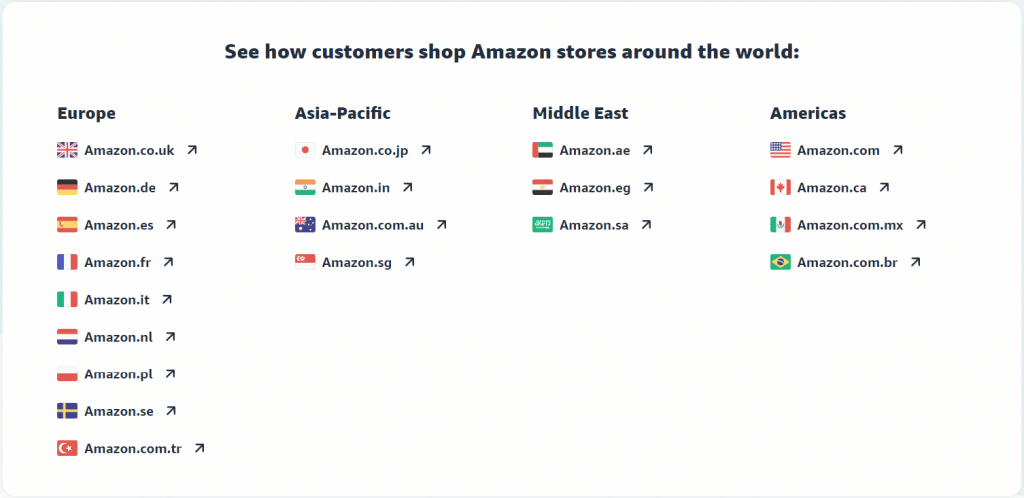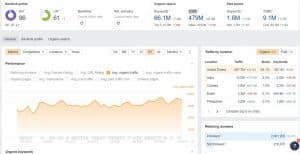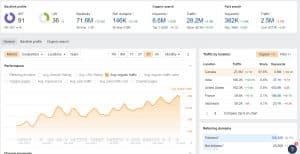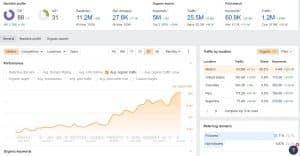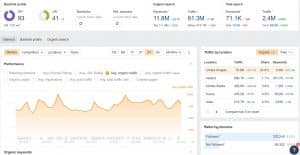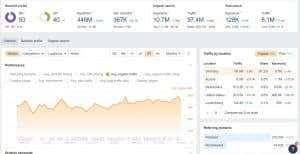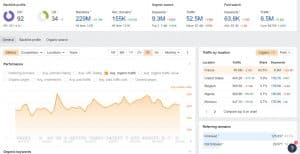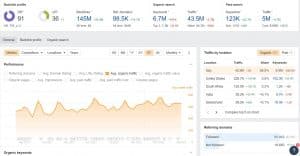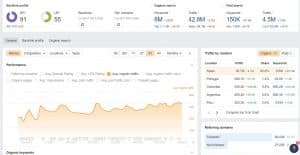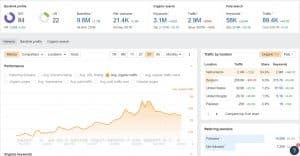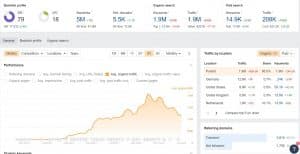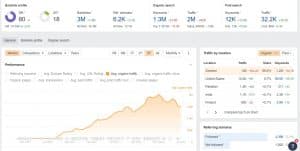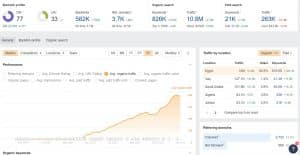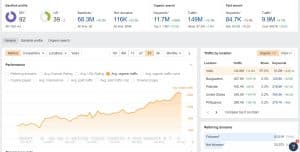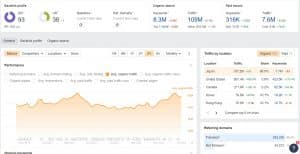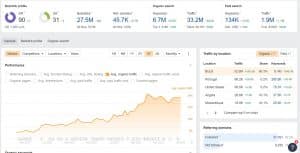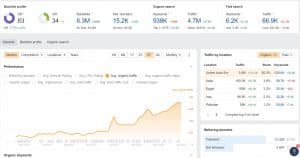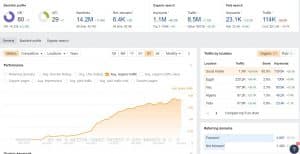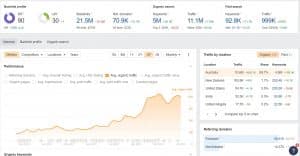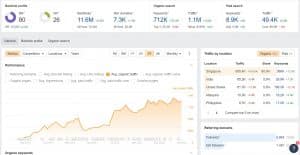Amazon Marketplaces: Stats, History, and Trends

To say that Amazon is an ecommerce giant is a grave understatement, having grown from a humble online bookstore to the biggest online marketplace in the world. Since its inception roughly three decades ago, it has launched a bunch of other marketplaces and allowed sellers to sell their products internationally and reach more customers across the globe.
In this article, we’ll break down the histories and defining features of each of these Amazon marketplaces. We’ll also take a look at their average monthly traffic using data from Similarweb for the month of December 2022 to help you decide where to expand your online business.
Related Reading: From A to Z: The Complete History of Amazon
Amazon North America (Unified Account)
The most prominent Amazon marketplace is Amazon.com, but not many know that Amazon actually offers a North America Unified Account, which means NA-based sellers can switch between Amazon.com, Amazon.ca (Canada), and Amazon.com.mx (Mexico) without having to create a separate account for each. This comes with the ability to create listings in one, two, or all three of these marketplaces.
Also Read: What is Amazon North America Remote Fulfillment Program?
The table below shows how robust Amazon.com is compared to international marketplaces, with nearly 3 billion site visitors every month. This stat is a double-edged sword however, as it also means that Amazon.com is the most saturated and competitive marketplace, not to mention the most prone to seller and customer fraud if only due to the sheer volume of transactions everyday.
This is why sellers in North America take the easy win and use Amazon’s NARF program to reach customers within NA but outside the US.
| Marketplace | Language | Average Monthly Traffic |
| Amazon.com | English | 2.7 billion |
| Amazon.ca | English | 193.4 million |
| Amazon.com.mx | Spanish | 113.9 million |
Amazon.com
Amazon.com is the granddaddy of all Amazon marketplaces, drawing in nearly 3 billion site visitors every month and being home to over 350 million products sold by Amazon itself and by its community of third-party sellers.
Even though .com is mainly geared towards US shoppers, orders made here are available for delivery to most countries where Amazon’s carrier services operate. Similarly, even though it caters mainly to US-based sellers, a good number of all .com sellers are based outside the US—more than half of the top marketplaces sellers are from China.
Amazon.ca
The Canadian version of Amazon launched in 2002. It has since been a go-to destination for US sellers looking to expand their customer base, or even Canadian sellers who are only just starting out. As of writing, over 40% of the sellers on Amazon.ca are based in the US.
Amazon.com.mx
Amazon Mexico was known as the “biggest ecommerce marketplace no one is talking about” for many years since its 2015 launching. Pre-pandemic surveys had it topping the lists of the fastest growing countries by retail ecommerce sales, beating even India and China. Currently, it’s one of the biggest marketplaces in Latin America, although it competes with equally robust online marketplaces tailored to the Lat-Am region such as Mercado Libre.
Amazon Europe
Just like in North America, signing up for an Amazon Europe account enables you to sell on a number of Amazon marketplaces in Europe:
| Marketplace | Language | Monthly Traffic |
| Amazon.co.uk | English | 428.2 million |
| Amazon.de | German | 500.4 million |
| Amazon.fr | French | 201.9 million |
| Amazon.it | Italian | 211.1 million |
| Amazon.es | Spanish | 170.2 million |
| Amazon.nl | Dutch | 26.5 million |
| Amazon.pl | Polish | 18.7 million |
| Amazon.se | Swedish | 16.6 million |
| Amazon.com.tr | Turkish | 41 million |
| Amazon.eg | Arabic | 20.2 million |
The biggest Amazon marketplaces in Europe based on website visitors are the United Kingdom, Germany, France, and Italy. However, Amazon has expanded its full service EU marketplaces throughout the years, with the latest addition being the Polish and Egyptian marketplaces.
Amazon.co.uk
Amazon’s ecommerce model arrived in the UK almost as soon as the original site was founded (3 years thereafter to be exact), which is why it should come as no surprise than established sellers on Amazon.com also list their products on Amazon.co.uk, which draws a hefty 400 million visitors per month and services over 20 countries in Europe.
Amazon.de
Launched at the same time as Amazon.co.uk in 1998, Amazon Germany attracts over 500 million visitors every month. Like Amazon.co.jp (Japan), it’s a colossal non-English (primarily) Amazon marketplace, which makes it a solid choice for sellers whose products are not susceptible to language barriers. It also usually crops up in lists of Amazon marketplaces hosting the most top sellers.
Amazon.fr
Although not as buzzing with traffic as its UK and Germany counterparts, Amazon’s France marketplace draws a decent 200 million visitors per month, which makes it an ideal destination to expand into, especially for NA sellers seeking to expand into a not-so-saturated EU marketplace.
Amazon.it
Amazon’s Italy site is a middling marketplace comparable to France, drawing a little over 200 million visitors monthly. Notably, antitrust enforcement in the EU, particularly Italian regulators, are more stringent than those in the US, having previously hit Amazon with investigations and fines over anti-competitive marketplace practices.
Amazon.es
Drawing just under 200 million site visits monthly, Amazon Spain provided sellers with more than $500 million in sales since its inception in 2011. Sellers who also operate in Latin American marketplaces usually look at Spain as their first entry into Europe.
Amazon.nl
Amazon Netherlands is among the youngest Amazon marketplaces as of writing, having expanded beyond ebooks to become a full service marketplace in 2020.
Amazon.pl
Amazon’s Poland marketplace launched only in 2021 and its reach is comparable to other new marketplaces like Netherlands and Sweden.
Amazon.se
Similar to the Netherlands, Sweden also only recently got its full service Amazon marketplace, and it currently draws over 16 million site visitors.
Amazon.com.tr
Amazon Turkey was launched in December of 2017, becoming the company’s first European marketplace outside the European Union. In 2022, Amazon opened its first fulfillment center in Istanbul, providing over 1000 jobs and enabling sellers to avail of essentially the same services as Amazon FBA in the US.
Amazon.eg
Similar to the two Middle Eastern marketplaces above, Amazon Egypt was originally Souq since 2017 before it was formally rebranded as Amazon.eg in 2021. It is the first Amazon marketplace in Africa.
Standalone Amazon Marketplaces
There are also fully functioning Amazon marketplaces that draw hundreds of millions of eyeballs per month, such as India, Australia, and Japan. The table below shows the potential market for each of these individual Amazon marketplaces.
| Marketplace | Language | Monthly Traffic |
| Amazon.in | English | 325.2 million |
| Amazon.co.jp | Japanese | 623.7 million |
| Amazon.com.br | Portuguese | 168.8 million |
| Amazon.ae | English | 23 million |
| Amazon.sa | Arabic | 15.6 million |
| Amazon.com.au | English | 63.1 million |
| Amazon.sg | English | 8.3 million |
Amazon.in
Amazon India is a marketplace of its own and its over 350 million monthly visitors has proven attractive to even US-based sellers, especially those who already work with factories in China and India itself. India is also home to a busy ecommerce ecosystem, with big sites like Walmart-owned Flipkart also taking a huge share of the ecommerce pie in the country.
Amazon.co.jp
Drawing the most traffic out of all standalone Amazon marketplaces, at over 600 million, Amazon Japan is also a solid choice to expand your business. Its biggest strength is its own domestic Amazon FBA services, which lets you run an ecommerce store conveniently as you would on Amazon.com. The most popular categories on this marketplace include OTAKU products, electronics, and toys.
Amazon.com.br
Founded in 2012, Amazon Brazil draws a decent 160+ million monthly site visitors, which makes it a no-brainer for sellers looking to tap into the Latin American market—a 2020 survey revealed that Latin America is the fastest growing ecommerce market globally, edging out North America and Europe.
Amazon.ae
Amazon United Arab Emirates launched in 2005 in Dubai following the ecommerce giant’s acquisition of Souq.com for half a billion dollars. Souq was later rebranded as Amazon.ae in 2019 for the UAE market, and as Amazon.sa in 2020 for the Saudi Arabia market.
Amazon.sa
The Saudi Arabia counterpart of Amazon.se (UAE) launched only in 2020, but has since operated with at least 12 Amazon sites with plans for new launches in 2022-2024.
Amazon.com.au
Also relatively young, Amazon Australia was launched in 2017, but has since attracted US-based Amazon sellers who want to reach ecommerce shoppers down south, with its over 60 million visitors per month and less competitive seller ecosystem compared to other more established marketplaces.
Amazon.sg
Amazon’s biggest hurdle in entering the Southeast Asian market are established marketplaces in the region, namely, Lazada and Shopee, but it did silently launch Amazon Singapore in 2017 and has consistently shown interest in growing its market share in the region.
How to Sell on International Amazon Marketplaces
Selling internationally on Amazon is quite easy as of 2023, you only need to head over to the Amazon Global Selling page, find the marketplace you want to expand into and work on your listings and logistics as you normally would on Amazon.com. Amazon itself has a pretty robust international logistics network that can help you fulfill orders internationally.
Related Reading: Amazon Global Logistics: How to Get Your Shipments Into Amazon FBA Faster
Conclusion
There’s a plethora of Amazon marketplace outside the biggest one (Amazon.com). Knowing what sets these marketplaces apart and expanding your business internationally is an effective way of growing your ecommerce brand.
Where are you looking to expand your Amazon business? Let us know in the comments below.
